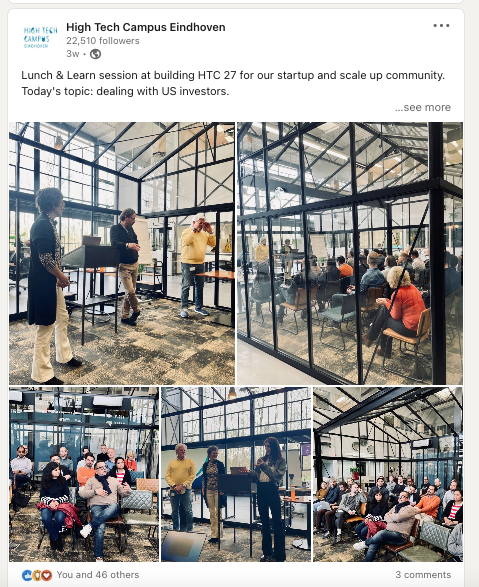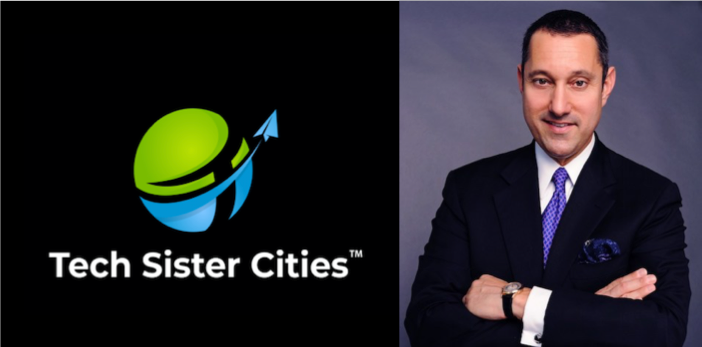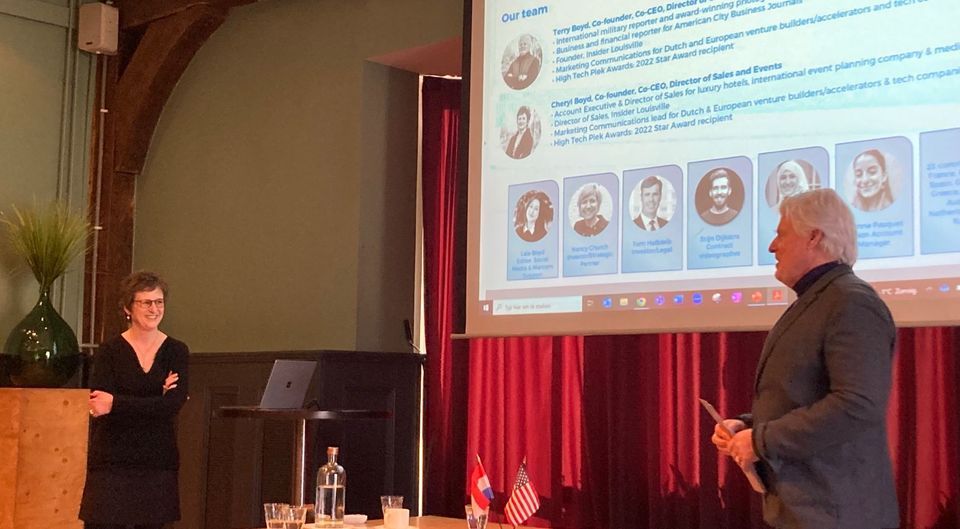(Editor’s note: This “Navigating American Investors” edition of the Eindhoven Business Briefing is part of Dispatches’ Tech Tuesday series. We cover the startup world because so many of our highly skilled internationals are entrepreneurs.)

We – my co-CEO/wife Cheryl and I – were honored to be chosen recently to present the inaugural Lunch & Learn event at High Tech Campus Eindhoven.
The topic was, “Navigating American Investors,” and in the interest of full disclosure, it’s a variation on a presentation we gave for BOM’s Medtech Trade Mission to Minneapolis. That presentation was focused on helping scale-ups and larger companies understand the expectations of potential investors/partners in Minneapolis, a medtech hub and home to Medtronic and other global companies.
“Navigating American Investors” is for Europe-based startup teams who want to go to the U.S. to raise early stage capital. (We can help with that.) I’d recently returned from taking clients to meet with investors, so some of these tips were learned the hard way on that trip.
Our Lunch & Learn in the HTC 27 startup hub was one hour – 20 minutes for our talk and 40 minutes for questions and comments. This is the Cliffs Notes version to get you started.
So, let’s get started:

Business American Style
We always start by citing international private equity investor Jonathan Blue of Blue Equity in our presentations. We brought Jonathan here in 2018 for “Eyes Wide Open,” his full-day event of connecting with Eindhoven’s ecosystem.
The first thing Jonathan told everyone in his talk at High Tech Campus was, “You’re going to get one shot. Make sure you’re prepared.” We’ve lived by that mantra ever since.
Pace
The biggest difference between American and Dutch business cultures is the pace at which negotiations – and one hopes, deals – move.
✓ Deals happen quickly, and things never slow down. American investors don’t want you to grow slowly and cautiously. Early-stage investors and venture capitalists want you to get to market quickly so they get an exit. Tell them clearly how you will make them money. Because money is the point, and how Americans keep score.
✓ Be prepared to move quickly. American investors are going to ask how you’d use an injection of fresh capital to get to the next funding round. “Growing the team” doesn’t cut it. If you can’t answer in detail, and with a coherent strategy, you flunk the test.
✓ American investors have already seen your pitch deck. Have your business plan and financial docs ready to send in case they ask for them.
✓ Be available for quick follow-up meetings, even during your holiday. This is important because there are no holidays in the U.S. Follow up with an email after important meetings.
✓ Never put potential investors on the spot by blurting out, “So, what do you think?” They’ll tell you want they think when they’ve analyzed the empirical data. But you may ask about the next steps or where you go from here.
✓ Be on time! “On time” is late. Ten minutes early is on time. That said, don’t be surprised if VCs and private equity people keep you waiting. It’s just a tactic to beat you down. Should you even be talking with these particular investors? Do your research.
✓ If you have a billion dollar idea, push back. Don’t take a bad deal.
✓ Know the differences between angel investors, venture capital and private equity.
✓ PE investors want to take control of your company, and they will replace you.
Communication, American style
“I get 50 pitch decks each week. I throw out 48 of them because of misspellings and grammatical errors.” – Jonathan Blue, Blue Equity
What Jonathan means is, if you don’t care enough to have professionals create and/or edit your deck, then you’re not serious.
What American investors say, and what they actually mean
– “Interesting” does not mean “interested.” Too many startups come back from the States saying they have an interested investor because someone said, “Interesting.” Interesting is American for “Oh, hell no …”
– “We’re in” and “We really want to make this happen” means “Get a lead investor. It’s not us.”
Say what you mean
– Tell investors EXACTLY how much capital you’re raising, not a vague range of, say, $2 million to $10 million. And if you tell them you only need a few hundred thousand dollars, they’ll never take you seriously. They know you can’t turn a startup into a publicly traded company with a few hundred thousand dollars. Take what you would ask from a European VC and double it. Maybe triple it.
– Don’t be humble! Americans want to deal with confident teams.
– Do NOT use qualifiers! Don’t say, “We aim to … We hope to …” Americans don’t invest in hope. Use declarative language. “We ARE developing …” “We WILL launch in the fall …” “We HAVE sold this many units …”
It’s okay to say to prospects, “If you’re going to tell me no, tell me fast.” We say this a lot. We’re Americans. You can’t hurt our feelings.
Bonus tips
✓ Never read your pitch deck in your meeting. Use it as a prompt and make eye contact with everyone.
✓ If you don’t understand something, ask for clarity. Americans use lots of jargon, euphemisms and sports metaphors.
✓ Decide who is the best communicator. It’s not always the CEO.
✓ Be careful with email. It’s easy to misinterpret the tone.
✓ Add the phonetic spelling of your name on your pitch deck so Americans know how to pronounce it. They feel uncomfortable right out of the gate trying to guess at names that – to them – are a baffling combination of sounds.
Practicalities and “good to know” information
✓ Connect on LinkedIn quickly after a good meeting.
✓ Always shake hands firmly, not softly as in Europe and the Middle East.
✓ Take an ample supply of business cards. Americans still use them.
✓ Buy travel health insurance! A hospital visit in the U.S. can come in at $20,000 or more. We know an Eindhoven-based entrepreneur who was hospitalized during the pandemic at a big tech show, but who was savvy enough to have coverage that saved them from being charged tens of thousands of dollars.
✓ Wait to be seated in American restaurants. Beware: Most American restaurants do not bring credit card machines to the table. They take your credit card back the servers’ counter. Go with them and make certain no one is capturing your account information.
✓ In the U.S., whomever invites the other person pays for meals and drinks. Don’t go Dutch! And tip your server. In the U.S., it is customary to tip your server 15 percent to 20 percent of the total bill as they only earn $2.13 per hour.
✓ Be aware of grocery prices! Food is exponentially more expensive in the U.S.
The bottom line is, if you want to play in the Big Leagues in the U.S., you have to know the rules.
About Dispatches Media: Dispatches, based in Eindhoven, is a communications company that includes Tier1 Tech Talent agency and Tech Sister Cities, which connects American and European ecosystems. If you’re interested in raising capital in the U.S., ping us at: [email protected]
Co-CEO of Dispatches Europe. A former military reporter, I'm a serial expat who has lived in France, Turkey, Germany and the Netherlands.















